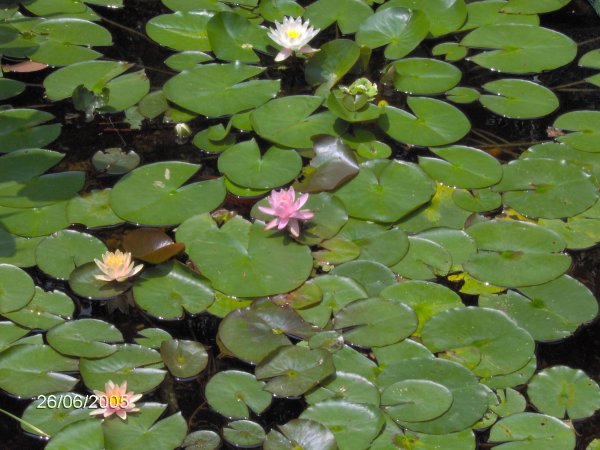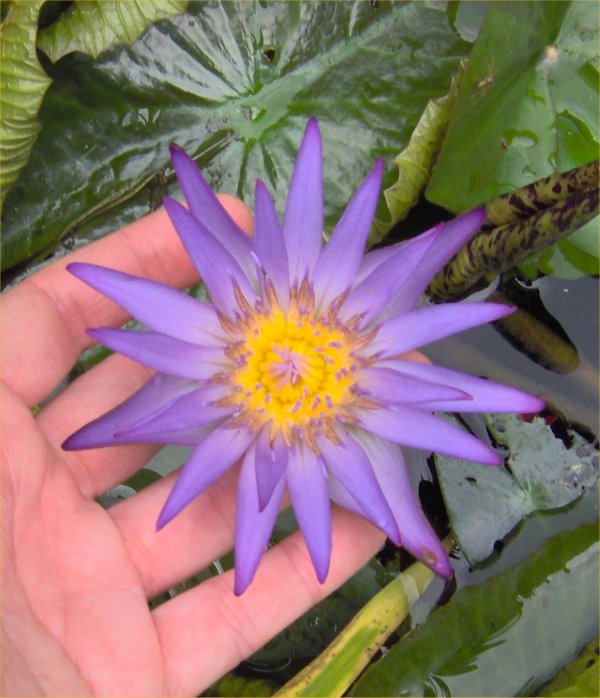 |
 |
|
|
Last Updated: 2/21/14

Introduction to Lily-Like Plants
Water Lilies
Lotuses
Other Lily-Like Plants
Germinating Lotus Seeds
Removing Spent Water Lily Flowers and Leaves
Waterlily and Lotus Links
Links to information on waterlilies and lotuses on other of my pages:
There are lots of photos of water lilies and lotuses on my pond pictures pages as well as Pond Showcase.

There are a number of lily-like plants or plants where only the leaves and flowers float on or slightly above the surface. The roots must be anchored in dirt or gravel with a high nutrient content. Thus, these plants usually require fertilization or roots exposed to the water column or detritus layer of a pond rich in nutrients. Lily-like plants have characteristics of both marginal and floating plants. They are often considered marginals but they tend to grow in deeper water.


Lilies are the obvious lily-like plant because they are lilies! Lilies are usually potted in 5 gallon pots and have to be fertilized and repotted every 1 to 2 years. During the growing season, lilies require fertilizer pills every month or so if they are to bloom at their best. Some ponders have experimented with soil-less planting and relied on the water (with fish waste) to fertilize the lilies and report okay results. To bloom well, lilies need 6 to 8 hours of full sun every day. In shaded ponds, the lily pads may grow but the lily probably will not flower. In full shade, the lily pads may not even survive. Lilies bloom all summer, and most ponders desire them in their ponds. Dwarf varieties can be used in small ponds. There are hundreds of varieties. Hardy lilies come in yellow, white, red, pink, and changeable (usually orange, yellow, red, etc.). Tropical lilies come in those colors as well as blue. Hardy lilies and dayblooming tropical lilies bloom from about 10 am to 3 or 4 pm. Nightblooming tropical lilies bloom during the evening and night. Many tropical lilies are fragrant and hold their flowers off the water whereas hardy lilies carry their flowers on the water. Pollinators (bees and hummingbirds) will frequent the blossoms which last one to three days each depending on the variety.
Hardy lilies have small pads that are mostly green. Tropical day-bloomers have larger pads that may have more fancy leaf colors with some rippling around the edges. Tropical night-blooming lilies have large pads with sharp spikes on the edges.
There are also two species of Victoria lilies and various crosses of those that can be kept in larger ponds. Victoria lilies have pads that are many feet across and can hold a small person! Some have their edges turned up so they look like huge bowls. Victoria are tropical and bloom at night with white flowers that may have subtle amounts of pink or yellow. The Victoria Conservancy is the place to ask about Victoria.
Photos of a pond at the National
Zoo on 9/14/07 with Victoria lilies:
Pond with Victoria lilies
Close-up of Victoria lily
flower
So which is correct: Water lily or waterlily? I have seen both used interchangeably and cannot find any answer to this vexing question.
Water Lily Types:
Types of Water Lily Tubers/Rhizomes:
This site (pdf file) includes photos of the various water lily tubers.
My tropical waterlily has tubers in the fall that are like walnuts. I think I have all the kinds of tubers. I certainly have the Marliac tuber in one of my lily pots which is like a horizontal pineapple (not the "pineapple" tuber referred to above though which is for tropicals; I think my tropical with the walnut tubers must be that kind; the pineapple flesh part falls away as the plant prepares for winter, leaving only the hard nut-like tuber).

Lotuses are large plants that have some things in common with lilies. They require 8+ hours of sun daily to flower well, a large pot, and monthly fertilizers. Lotus need longer periods of warm (80 degrees F+) days to flower. They put out fewer flowers than lilies. Their pots must be larger, in the 7 to 50 gallon range depending on the variety and how often you want to repot. If the pot is too small, they will jump the pot and send out runners and be less likely to flower. Unlike lilies, they send out huge leaves that are held on stalks many feet into the air. The flowers are also many feet in the air. In the spring, the first leaves are like those of the lilies, floating on the water. The final air-born leaves can be up to 2 feet across! The flowers can be a foot across. Lotuses should be contained in pots in a larger pond or in a pond of their own as they are invasive. Lotuses should be repotted in the early spring (about March in Zone 6/7). I had a lotus in a 12 gallon tub pond that I needed to repot every fall and spring so that I could lower it into my big pond as the tub pond froze solid in winter. I would later retire that tub pond and just keep the lotus in a 7 gallon pot in the 1800 gallon pond.
Photos from Lilypons on 9/2/07
of fields of lotuses.
A pond of flowering
lotus
A pond of flowering
lotus
Close-up of a lotus
flower
From 3/8/12 when I repotted my lotus in to a 7 gallon pot in the 1800 gallon pond and a 12
gallon tub pond:
Repotting lotus - 12 gallon tub pond, pile
of lotus tubers
Lotus tuber - showing the starchy tuber
(for energy strorage) and growing tip with leaf coming out
Lotus in dirt - being repotted in 7 gallon
pot
12 gallon lotus tub pond - all potted
up
Lotus tubers on 3/17/13. These are the ones that I stored over the winter in a mesh bag and repotted in to the 12 gallon Lerio tub pond.

Snowflakes:
Snowflakes have pads that are green mottled with red from 1 to 3 inches across. Their flowers are either yellow, white, or orangish yellow and may be star or bell shaped. They spread by runners and banana-like tubers which break off from where the seeds were attached and sink to the bottom to grow next season. In the portion of my pond with pea gravel on the bottom, they can sprout up anywhere. They can be invasive but are easy to remove and provide shade for the fish and beautiful flowers for the ponder. They can be planted directly in gravel or potted without fertilizer. They will stray from the pot. Snowflakes may not overwinter well. The first few years of my pond, the snowflakes were gorgeous and spread all over. Now, I only have a few leaves and flowers around.
The few other lily-like plants that exist, such as floating heart, have similar characteristics and requirements as snowflakes.

To germinate lotus seeds, you cannot just dump them in some wet soil or a pail of water. First, you must be sure that they are fertile. Fertile seeds are larger and hard. Infertile seeds are shriveled up. Anchor each seed in a vice. Then, use a file to file (large ones for wood, plastic, and metal are okay but a nail file is too, although it takes longer) through the dark seed coat. Once you see a white to yellow spot, you have broken through. When I tried this, the seeds kept slipping out of the vice so I just cracked them (barely, do not split them) with the vice, and they later sprouted. Place the filed seeds in some pond water. Every day, replace the water with fresh water or bacteria and/or fungus will grow. When something begins to sprout, place the seed right on the surface of some mud but into it a little. Keep the mud wet but do not put a lot of water over the seed. Once it starts to put out leaves and good roots, put it in the pond under just a few inches. You may need to protect it from any fish. Every few weeks, lower it a bit until it is about 3 to 6 inches deep, depending on whether it is a dwarf or giant variety.
Here is a useful web site:
Growing Lotus From
Seed

Someone asked me in my forum about this on 6/2/06. Here was my response.
"In an ideal world, one would get special trimmers and cut the leaves and flowers back to near where they started once they start to rot. So, you would cut off all the stem the flower or leaf is on as it would just rot. In the case of flowers, when they sink. In the case of leaves, when they turn yellow and later brown or when they are severely damaged by pests or anything like fish messing with them. Rotting lily leaves are extra attractive to the ever-present aphids.
I usually don't bother with the flowers, mostly because I have so few. I just let them do their thing. They sink and usually fall off. If I find them then, I remove them. For the leaves, once a week when I get in, I hand pull off the dying leaves, snapping them off somewhere between the leaf and base. It's not ideal but I'm too lazy to submerge metal pruners methodically to remove dozens of leaves sometimes in the exact proper manner. The rotting leaves pull off pretty easily on tropical lilies. It's a different story for my big tropical. Those I sometimes have to cut off because they don't pull off."

These links were last checked on 4/28/06. Please contact me if you find a good water lily or lotus link to add here.
International Waterlily and Watergardening Society
Victoria Adventure - a large site on Victoria lilies and other lilies, lotuses, and pond plants.
Nymphaea - an article on waterlilies
Nymphaea - an article on Botany World and Cultivation of the Water Lily which look mysteriously like the same text!
|
|
Go to the main plant page (full index).
Go to the aquarium algae index.
Go to the pond algae index.
Go to the aquarium plant index.
Go to the pond plant index.
See the master index for the plant pages (quick index).

|

|
E-mail RobynCopyright © 1997-2026 Robyn Rhudy |

|
 |